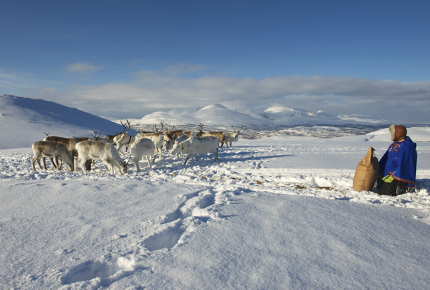Top 5 ethical trips to indigenous communities
From canoeing through remote Ecuadorian rainforest with the Huaorani to exploring Swedish Lapland with the Sámi, we round up the most ethical ways to visit an indigenous community.
An increase in ethno-tourism trips (tourists visiting indigenous peoples to better understand their cultures) has coughed up concerns regarding the practice.
While most encounters are respectful, a number of tour operators are exploiting these communities for financial gain, which has led to harmful consequences for the indigenous peoples.
So how can you visit these communities without fanning the exploitation fire? It’s all to do with picking the right operator.
Tourist Concern’s Mark Watson and the team behind the World Responsible Tourism Awards have recommended the five trips below, all of which are guaranteed to humble visitors without humiliating their hosts.
1) Huaorani, Ecuador
The Huaorani Ecolodge sits in deepest, dampest Ecuador, where the Shiripuno River twinkles through Amazonian rainforest and curious kiskadees and kingfishers call from the trees.
As one of the country’s most remote eco lodges, it’s only accessible by quilla (traditional dugout canoe). Home to the Huaorani, a people un-contacted by the outside world until 1956, trips here offer fulfilling interactions with the community.
Winner of the Best Tour Operator for Cultural Engagement at the World Responsible Tourism Awards, visitors are taught traditional survival techniques and local dialect by the Huaorani, as well as learning about their ongoing fight against oil exploration.
More information:www.huaorani.com
 The Huaorani weren't contacted by the outside world until 1956
The Huaorani weren't contacted by the outside world until 1956The Huaorani Ecolodge
2) Dukha, Mongolia
Visiting locals respectfully is key to Eternal Landscapes, a tiny ethical tour operator recommended by Tourism Concern, that concentrates on adventurous experiences throughout the rugged mountains and wilderness of Genghis Kahn country.
Offering various tours that allow travellers to interact with Mongolian communities, including homestays with Dukha nomads, Eternal Landscapes consciously reduces its impact through water conservation, waste minimisation and several other sustainable practices.
It also ploughs profits back into worthwhile local projects, so when you’re staying in a small ger camp (traditional felt tent camp), buying ingredients to make nogoon buuz (vegetable dumplings) from the local market, you know you’re helping the immediate community.
More information:www.eternal-landscapes.co.uk
 Eternal Landscapes runs homestays with Dukha nomads in Mongolia
Eternal Landscapes runs homestays with Dukha nomads in MongoliaAdamWong28 / Thinkstock
3) Iraqw, Tanzania
Not only will tourists encounter safari’s Big Five (the African lion, African elephant, Cape buffalo, African leopard, and black rhinoceros) with IntoAfrica’s excellent Tanzania Explorer itinerary, but they will also enjoy ethical interactions with the Iraqw and Maasi peoples.
Advocated by Tourism Concern, these indigenous encounters take place with the full co-operation of both communities, and trips also include schemes that assist local projects.
So with the backdrop of Serengeti sunsets, you can try the local Iraqw cuisine as musicians perform traditional songs or learn customary skills such as jewellery making. Elders are on hand to teach visitors about the history of their community as well.
More information: www.intoafrica.co.uk
 IntoAfrica offers ethical interactions with the Maasi and the Iraqw
IntoAfrica offers ethical interactions with the Maasi and the Iraqwnok6716 / Thinkstock
4) Sámi, Sweden
Centuries of persecution nearly drove the Sámi from the Arctic region of Sápmi (predominantly northern Sweden and Norway). They were about ready to abandon their reindeer-herding livelihoods and leave their ancestral lands.
However, thanks to a rise in respectful yet profitable cultural tourism, the Sámi’s traditional existence is becoming viable, as we found out when we visited.
On a white sheet of snow below the dancing aurora borealis, those who travel to Sápmi with Nutti Sámi Siida, a Sámi-run ecotourism company, will experience hands-on lessons in indigenous Sámi culture. Expect rides in handcrafted sleighs and traditional Sápmi slow food, served by the open fires in giant lávvu-tents.
More information: www.nutti.se
 Nutti Sámi Siida offers hands-on lessons in indigenous Sami culture
Nutti Sámi Siida offers hands-on lessons in indigenous Sami cultureDmitryChulov / Thinkstock
5) Maasai, Kenya
Africa is a hotbed of faux pas when it comes to indigenous ethno-tourism, with exploitative, unauthentic and disrespectful tribal meetings cobbled together for tourist camera lenses.
The Naboisho Conservancy in Kenya, highly commended in recent World Responsible Tourism Awards, avoids these pitfalls by pairing visitors with guides from Africa’s Maasai people. This means that travellers are typically taken to the village where their guide grew up, not one attempting to appear traditional in order to bolster its touristic appeal.
The company also specialise in ethical wildlife safari tours, with a 20,200-hectare (50,000-acre) conservancy made up of land contributions from 500 Maasai landowners. It is home to one of the highest lion densities in the world, alongside the indigenous Maasai population.
More information: www.maranaboisho.com
 Meet the Maasai at the Naboisho Conservancy in Kenya
Meet the Maasai at the Naboisho Conservancy in Kenyaphotoempt / Thinkstock
Enjoyed this? You may also like:
Should we visit indigenous communities?
12 ethical experiences for 2015
Do you have any Feedback about this page?
© 2025 Columbus Travel Media Ltd. All rights reserved. No part of this site may be reproduced without our written permission, click here for information on Columbus Content Solutions.









 You know where
You know where